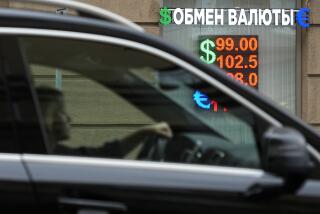Ruble Confusion Leads to <i> Dollarization</i>
- Share via
MOSCOW — The U.S. dollar is rapidly becoming the currency of choice in the Soviet Union due to growing confusion over the value of the ruble during the country’s struggle to become a market-driven economy.
Rubles are worth nothing outside the Soviet Union because the government refuses to back them with hard currency, gold or silver.
But inside the country, tourists can walk up to a Moscow hotel currency booth and buy six rubles for one dollar, or 16 cents each. If they use a credit card, they get 1.8 rubles per dollar, the so-called commercial rate.
On the black market, a dollar fetches about 20 rubles.
“Confusion reigns everywhere,” said Andy Rafalat, deputy general director of Moscow’s two Pizza Hut restaurants.
More firms are switching as many transactions as possible to hard currencies, the favorite being the dollar.
Leaders of the huge Russian republic, who want to make the ruble the only legal currency in the country, have coined a word for the trend: dollarization.
Until recently, foreign businesses had dealt only in the official ruble, known in Russian as valuta. Price tags and restaurant menus were printed in official rubles, for example.
The rate was replaced in November, however, by a new commercial exchange rate that devalued the ruble from 1.6 to the dollar to 1.8.
In his decree, President Mikhail S. Gorbachev indicated this rate was to cover all international commercial transactions by Soviet companies as well as joint ventures with foreign firms and foreign residents in the Soviet Union.
The official rate was retained only for international currency comparisons and to protect Third World countries whose debts are in rubles.
Finland, the Soviet Union’s closest Western trading partner, was so confused that its central bank stopped clearing ruble transactions for nearly a week.
In Moscow, the Swiss-Soviet joint venture Sadko kept its staff on overtime one night to change all its price tags. Ruble prices were tripled, but since the new ruble was worth only one-third of the old one, the hard currency price remained the same.
Pizza Hut started writing its credit card bills in U.S. dollars to avoid being charged the higher exchange rate by banks ignoring the new rules.
Explanatory notes have been stapled to all hard currency menus, and Rafalat said the company is considering reprinting them in dollars instead of rubles next month to make them easier to understand.
“The only 100% clear road I can see is by quoting prices in another currency. As we receive most of our hard currency in dollars, dollars seem to be the most obvious thing to quote,” he said.
More to Read
Sign up for Essential California
The most important California stories and recommendations in your inbox every morning.
You may occasionally receive promotional content from the Los Angeles Times.










